"Cheesecake!"
March 11,
2010 - Volume 1, Issue 04
| |
|
|
|
|
Yum!
|
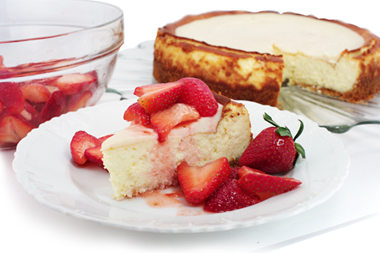
Cheesecake is one of the
top three favorite desserts in the country along with
pie and ice cream. Are we surprised? No! Creamy,
delicious, and with seemingly endless flavor varieties,
cheesecake sets the dessert table as easily at the
coffee shop as at the white linen bistro. In fact, it's
a weak dessert menu if there's not at least one
cheesecake offering. But, this wonderful creation is not
limited to dining out; it's quite easy to make at home
with minimal effort. In this issue, we expose the
secrets for making great cheesecakes, discuss baking
pans that will yield the desired results, and finish
with three marvelous cheesecake recipes for you to try.
You'll be pleased with the
results!
|
Ken's
Notes:
|
This has to be one of my
favorite newsletter issues so far. Cheesecake runs a
close second only to my Grandmother's Irish Soda Bread
as the most popular comfort food in our house. It's rich and sinful, everything a
good desert should be! Before I say anything more,
Dagmar has asked that I emphasize that the recipe
printed below is NOT her cheesecake
recipe. Many have asked, but none have been chosen to
receive that one. Feel free to get creative with your
baking - Dagmar once made a three-tiered wedding
cheesecake, decorated with fresh cut flowers and mint
leaves! It's rich and sinful, everything a
good desert should be! Before I say anything more,
Dagmar has asked that I emphasize that the recipe
printed below is NOT her cheesecake
recipe. Many have asked, but none have been chosen to
receive that one. Feel free to get creative with your
baking - Dagmar once made a three-tiered wedding
cheesecake, decorated with fresh cut flowers and mint
leaves!
If this is your first attempt, just
remember that getting your ingredients to room
temperature is very important. Plan ahead - don't rush.
At first glance we were a little surprised at the
ingredients in the Pesto Sun-Dried Tomato Cheesecake,
but don't let that stop you. It was different, yes, but
surprisingly good.
Cooking
Classes
We're starting to make some progress,
finally! Gayle Shank has enthusiastically joined us to
help develop and manage our class program. With her joy
for cooking and baking we're confident that we'll be
able to present you with  a program that's both fun and
educational. In the past, Gayle has owned and operated
her own bakery, was a pastry and sous chef at the Levee
House and a manager at Rossi Pasta. We're excited to
have her working with us and look forward to getting
started with our class program. a program that's both fun and
educational. In the past, Gayle has owned and operated
her own bakery, was a pastry and sous chef at the Levee
House and a manager at Rossi Pasta. We're excited to
have her working with us and look forward to getting
started with our class program.
Speaking of that
program, we need your help. With so many topics to
cover, we'd like to get your input as to which direction
we should go. We've put together a brief survey and
would like to invite you to take part in determining
what we should be covering first. Participation is
limited to the first 100 participants. If you can't take
it, you're probably number 101, sorry. Click here
if you'd like to take our survey.
Edible
Arrangements
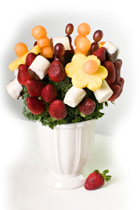 Foodies - This one's for you! I
don't know if you've seen their ads on TV or in the
paper recently, but we had the opportunity to try one of
the fresh fruit bouquets from Edible
Arrangements in Vienna the other day. Delivered
cold, with everything cut fresh that morning,
strawberries and apples dipped in chocolate, it was
delicious. If you're looking for a unique centerpiece
for a dinner party, which you can also use for dessert,
we urge you to try one of these clever
arrangements. Foodies - This one's for you! I
don't know if you've seen their ads on TV or in the
paper recently, but we had the opportunity to try one of
the fresh fruit bouquets from Edible
Arrangements in Vienna the other day. Delivered
cold, with everything cut fresh that morning,
strawberries and apples dipped in chocolate, it was
delicious. If you're looking for a unique centerpiece
for a dinner party, which you can also use for dessert,
we urge you to try one of these clever
arrangements.
| | |
|
Making
Perfect Cheesecakes
|
Cheesecake has received a
reputation for being difficult to make - we're not sure why -
it's much easier than most pastries, and the results always
delight even when they don't turn out just right! We'll take
things step-by-step and guide you to perfect cheesecakes - or
at least better cheesecakes!
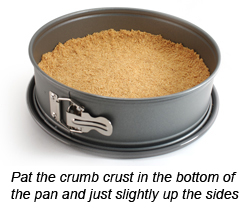 Crust - the ideal cheesecake
crust provides a complementary platform for the cheesecake.
Typically, recipes use a dry crumb moistened with a bit of
melted butter patted into the bottom of the pan. Unlike a pie,
a cheesecake crust covers just the bottom and a half-inch, or
so, up the sides. The crust helps to form a barrier between
the batter and the pan. After patting the crumbly crust into
the pan, place the pan in the freezer for 10-15 minutes while
mixing the batter. This serves to harden the crust into place
and prevent any shifting of the crust when the batter is
added. Many bakers choose to prebake the crust in the oven for
7-10 minutes prior to adding the batter. Crust - the ideal cheesecake
crust provides a complementary platform for the cheesecake.
Typically, recipes use a dry crumb moistened with a bit of
melted butter patted into the bottom of the pan. Unlike a pie,
a cheesecake crust covers just the bottom and a half-inch, or
so, up the sides. The crust helps to form a barrier between
the batter and the pan. After patting the crumbly crust into
the pan, place the pan in the freezer for 10-15 minutes while
mixing the batter. This serves to harden the crust into place
and prevent any shifting of the crust when the batter is
added. Many bakers choose to prebake the crust in the oven for
7-10 minutes prior to adding the batter.
Mixing the Batter -
Smoothness is the watchword when it comes to mixing the
perfect cheesecake batter. Cheesecake is primarily a cheese of
one kind or another, eggs, and sugar. In the U.S., cream
cheese is the common choice.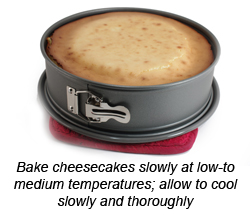 In Italy, it's ricotta cheese, and in
other regions, different forms of fresh, unripened cheese are
used. Have your ingredients at room temperature before mixing.
Start with beating the cheese on low speed into a very smooth
consistency; lumps will not disappear or dissolve during
baking, so this is the moment to achieve the desired smooth,
creamy texture. Eggs serve to thicken the batter when baking.
Add them one-by-one incorporating thoroughly into the cheese.
Using a low speed while mixing will prevent over-aerating the
batter. In Italy, it's ricotta cheese, and in
other regions, different forms of fresh, unripened cheese are
used. Have your ingredients at room temperature before mixing.
Start with beating the cheese on low speed into a very smooth
consistency; lumps will not disappear or dissolve during
baking, so this is the moment to achieve the desired smooth,
creamy texture. Eggs serve to thicken the batter when baking.
Add them one-by-one incorporating thoroughly into the cheese.
Using a low speed while mixing will prevent over-aerating the
batter.
Baking -
Cheesecakes typically bake between 325-350ºF, and for 1 to 1.5
hours. This low and slow strategy allows for even baking - the
outside will not be over-baked, and the inside will not be
under-baked. The first half of baking is crucial for allowing
air bubbles to expand and raise the batter. Avoid opening the
oven door to check progress; 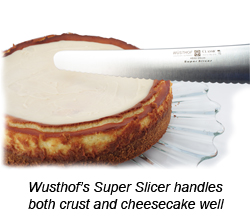 this will change the oven's
temperature and risk collapse of the forming texture. There
are "no-bake" cheesecake variations, but we tend not to think
of them as "real" cheesecakes. this will change the oven's
temperature and risk collapse of the forming texture. There
are "no-bake" cheesecake variations, but we tend not to think
of them as "real" cheesecakes.
Checking for Doneness - A
reliable, tested recipe is your best resource for timing when
baking your cheesecake. The center of the pan should be wiggly
and wobbly still; this may appear as underdone, but the center
will continue to cook and set up during the initial stages of
cooling.
Chilling - Allow the
cheesecake to cool on a wire rack until it reaches room
temperature - about 2 hours. Keeping the cheesecake in the
pan, wrap it well and refrigerate for at least 4-6 hours. The
famed chef, Dorie Greenspan, says in her book, Baking,
that the cooling and chilling process is just as important to
the finished cheesecake as the baking!
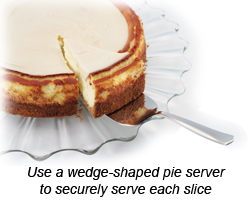 Serving - Cheesecake is
almost synonymous with "richness." Allow the cheesecake to set
at room temperature for 30 minutes prior to serving to remove
the chill just a bit. Where a 9-inch pie might be cut into
eight wedges, a 9-inch cheesecake graciously serves twelve. A
scalloped-edged knife glides through the cheesecake while
cutting neatly through the crust. Wipe the knife clean after
each cut. A pie server will deftly lift the slice to the
plate. A slice of cheesecake is typically served upright for
dramatic effect, but can just as easily be laid on its side
with toppings
applied. Serving - Cheesecake is
almost synonymous with "richness." Allow the cheesecake to set
at room temperature for 30 minutes prior to serving to remove
the chill just a bit. Where a 9-inch pie might be cut into
eight wedges, a 9-inch cheesecake graciously serves twelve. A
scalloped-edged knife glides through the cheesecake while
cutting neatly through the crust. Wipe the knife clean after
each cut. A pie server will deftly lift the slice to the
plate. A slice of cheesecake is typically served upright for
dramatic effect, but can just as easily be laid on its side
with toppings
applied.
|
Perfect Pans for Perfect
Cheesecake
|
A
finished cheesecake is fragile at the same time that it's
substantial and heavy. For good outcomes at the point of
serving, it's essential that you start with a proper pan.
There are two basic pan styles deployed when making
cheesecake; either style will ensure easy handling at finale
time.
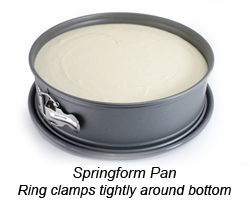
Springform Pans - This pan is
the common standard for cheesecake. The pan comes in two
parts, a bottom, and a circular band that forms its removable
sides. The band fits around the bottom and the clamp snugly
tightens the ring into place forming a leak-proof seal. Most
springform pans have 3-inch high sides that allow for lofty
baking. To remove a cheesecake or other baked good from a
springform pan, run the back of a knife or a spatula around
the edge, carefully unclamp and lift away the ring.
Removable Bottom Pans
- Some bakers prefer this type of pan for cheesecake.
The bottom of the pan sits on a "shelf" formed by the sides of
the pan. The weight of the batter presses the bottom and the
side ring together. When baking and chilling is complete, run
a blunt knife or spatula around the sides of the pan. 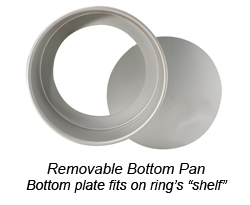 Holding the pan with one hand,
push the cheesecake up from the bottom. You may carefully
transfer the cheesecake from the pan's bottom, or keep the
bottom in place for serving. Removable bottom pans come in all
shapes, sizes, and heights and are useful far beyond the
cheesecake world. Holding the pan with one hand,
push the cheesecake up from the bottom. You may carefully
transfer the cheesecake from the pan's bottom, or keep the
bottom in place for serving. Removable bottom pans come in all
shapes, sizes, and heights and are useful far beyond the
cheesecake world.
Pan
Surfaces - The surfaces of baking pans vary in their
finish. For cheesecake, nonstick surfaces are a bonus since
the pan is not typically prepared by greasing and flouring as
with most cakes. Alternatively, parchment paper may be used to
line the pan's bottom and sides. The paper prevents any
sticking to the pan, and is easily removed.
Pan Height - Cheesecakes love
to loft during baking and our preference seems to be "the
taller the better" when it comes to a slice of cheesecake -
the soaring heights add to the decadence! Choose a pan with a
minimum of 3-inch sides. If needed, 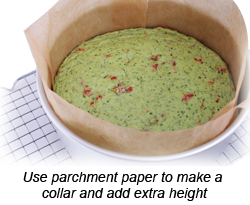 additional height can be had by forming a
collar of parchment paper while lining the sides of the
pan. additional height can be had by forming a
collar of parchment paper while lining the sides of the
pan.
Pan
Diameter - When making cheesecake, match the pan size
to your recipe. This will ensure that the baking time provided
in the recipe is an accurate estimate. For example, the volume
of a 9-inch pan with 3-inch high sides is 191 cubic inches;
the volume of a 10-inch pan with 3-inch high sides is 236
cubic inches. This is a difference of 45 cubic inches or 24%.
If you must adapt your baking to a different size of pan,
adjust the baking time
accordingly.
|
Cheesecake
Improv
|
Cheesecake's popularity is
due, in part, to its adaptability. The mild, slightly tangy
cream cheeses or ricotta cheeses accept a wide range of
flavors. It's only the imagination that is limited. Here are a
few of our favorite riffs on cheesecake:
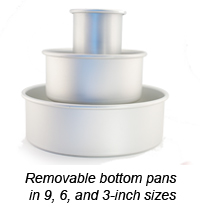 Savory Cheesecakes - The
savory side of cheesecake is a great discovery ahead of you if
you haven't already become familiar with this notion. A savory
cheesecake may be served as an appetizer, a spread, or as a
luncheon entrée accompanied by a green salad. (See the savory
recipe below). Savory Cheesecakes - The
savory side of cheesecake is a great discovery ahead of you if
you haven't already become familiar with this notion. A savory
cheesecake may be served as an appetizer, a spread, or as a
luncheon entrée accompanied by a green salad. (See the savory
recipe below).
Shift
the Size - While most cheesecake dreams evoke the image
of a slice, you may shift the expectation and presentation of
cheesecake by making different sizes of cheesecake. Both
springform and removable bottom pans come in varying
diameters. Choose a 3 x 3-inch pan for an individual
cheesecake, or a 6 x 3 pan for a savory appetizer version.
Ramekins are suitable for cheesecake only if they are also the
serving vessel; it is often difficult to remove a cheesecake
from a pan that does not have a removable bottom of one kind
or another.
Crust
Variations - The standard for cheesecake seems to be a
graham cracker crust. But, the world is big! Experiment with
complementary flavors: ginger snaps, vanilla wafers,
shortbread cookies, nut meals, or biscotti. For savory
cheesecakes, try crusts made of cheesy crackers, saltines,
crushed pretzels, or corn chips.
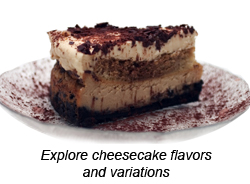 Batter
Variations - Once you've mastered a basic cheesecake,
the door to flavor variations opens wide! In the featured
cookbook below, Chef Geary offers hundreds of his personal
favorites. As you explore flavor additions think in three
directions - the crust, the batter, and any toppings. Batter
Variations - Once you've mastered a basic cheesecake,
the door to flavor variations opens wide! In the featured
cookbook below, Chef Geary offers hundreds of his personal
favorites. As you explore flavor additions think in three
directions - the crust, the batter, and any toppings.
Topping
Variations - Classic toppings of whipped cream or
sweetened sour cream are almost always appropriate with
cheesecake. Fruit, fresh or sauced, is the perfect visual
complement and a tasty pairing. Other sauces, fudge, caramel,
dulce le leche, or crème anglaise are all perfect
accompaniments.
|
Smart
Cheesecake Tips
|
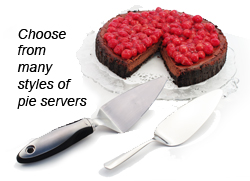 Tip #1: Cracks in cheesecake
can form while baking. Several factors can lead to cracking.
Bake your cheesecake in a medium to medium-low oven so that it
bakes slowly and more evenly. Cool the cheesecake gradually;
some recommend allowing the cheesecake to cool in the oven
with the door propped open. Cracks may also form if the
cheesecake has baked too long; don't overbake. Tip #1: Cracks in cheesecake
can form while baking. Several factors can lead to cracking.
Bake your cheesecake in a medium to medium-low oven so that it
bakes slowly and more evenly. Cool the cheesecake gradually;
some recommend allowing the cheesecake to cool in the oven
with the door propped open. Cracks may also form if the
cheesecake has baked too long; don't overbake.
Tip #2: If your cheesecake
develops a crack, don't sweat it. Repair the crack by
smoothing the baked batter, or camouflaging it with toppings.
Tip #3: Wrap
your cheesecake well when chilling; it will easily pick up any
odors present in your refrigerator.
Tip #4: Use fresh cream
cheese for your cheesecakes. Cream cheese does not freeze
well, i.e., don't buy a lot of it on sale hoping to stockpile
for the future. Freezing changes the cream cheese's texture
making it unsuitable for use. Do not substitute non-fat cream
cheese or whipped cream cheese in your recipe - they do not
mix or bake the same way as regular cream cheese.
Tip #5: Carefully store both
springform and removable bottom pans so that they are not
subject to warping or bending. We dry our springform pan very,
very well, then store in a nearly clamped position.
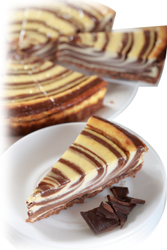 Tip #6: The pan's bottom may
be kept in place when plating and serving, but if you would
like to transfer the cheesecake from the bottom, line the
bottom with parchment paper to minimize any sticking of the
crust. Use a broad cookie spatula or circular cake spatula to
manage the transfer. Tip #6: The pan's bottom may
be kept in place when plating and serving, but if you would
like to transfer the cheesecake from the bottom, line the
bottom with parchment paper to minimize any sticking of the
crust. Use a broad cookie spatula or circular cake spatula to
manage the transfer.
Tip #7: Some cheesecake
recipes call for baking cheesecake in a water bath for more
even cooking. Place the cheesecake pan on a sheet of aluminum
foil and fold up the sides to prevent any water seepage into
the pan.
Tip #8:
Baked cheesecakes freeze very well. Remove a chilled
cheesecake from its pan; allow it to freeze well while placed
on a plate or cookie sheet. Once frozen, wrap well and freeze
for up to four months. Thaw frozen cheesecake overnight in the
refrigerator.
|
Q
& A's
|
 Q: Q:  What is cream cheese? What is cream cheese?
A:
Cream cheese is a fresh, unripened, pasteurized
cheese comprised of 33% milk fat with a slightly acidic
character from the lactic acid formed by introduced bacteria.
The fat content of cream cheese is higher than most cheeses
making it a common substitute for butter. Cream cheese is
often compared to the French Neufchatel cheese that is similar
in texture and acidic taste, but is ripened unlike American
cream cheese.
Q:
What is a New York-style cheesecake?
A:
Different explanations exist for this cheesecake term.
Generally, the origins converge around a cheesecake that is
made with cream cheese (as opposed to ricotta), and with just
the flavors of the cheese, egg, and sugar. The popularity of
cheesecake in New York City in the 1930s, no doubt, has played
a role in the colloquial term.
Q: What is parchment
paper?
A: Parchment paper is paper with
integrated silicone. The silicone can handle heat where waxed
paper cannot. Parchment is a common baking liner that is
moisture, grease, and heat resistant. However, parchment is
still paper and will burn around the magic number of
451ºFarenheit. Avoid its use in broiling or in toaster ovens
where the heating element may be too close to the paper.
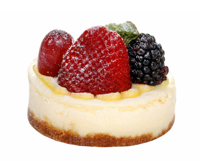 Q: Many baking pans are made
from "anodized aluminum." What does this term
mean? Q: Many baking pans are made
from "anodized aluminum." What does this term
mean?
A: Anodized aluminum is the result of
aluminum exposed to an acid-induced oxidation process. This
chemical process hardens aluminum in a special way that makes
it especially durable. Heat is transferred evenly through
anodized aluminum. A natural finish exists with anodized
aluminum that creates an inert surface, i.e., aluminum will
not transfer from the pan to the food. Pans may be prepared as
"hard anodized" or "silver anodized." A hard anodized pan is
processed longer and has an even harder surface. Wash all
anodized aluminum pans by hand, and never in the
dishwasher.
|
Cookbook
Review
|
The
Cheesecake bible by George Geary. Copyright 2008.
Published by Robert Rose Inc., Toronto, Ontario,
Canada.
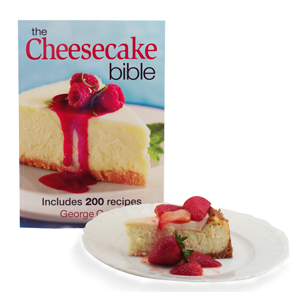 Who knew there could be so many
different kinds of cheesecake? George Geary has assembled a
compendium of hundreds of cheesecake recipes that cover some
serious culinary ground with their range of flavors and
combinations. He tutors us through the basics in the first
chapter, then unleashes the possibilities with following
chapters such as "Chocolate Cheesecakes," "Citrus
Cheesecakes," "Nut Cheesecakes," and many other chapters. We
especially enjoyed the chapter on "Savory Cheesecakes" where
wonderful flavors are brought to the richness of the
cheesecake world. He helps us explore small cheesecakes,
classic and inventive toppings, and concludes with a series of
"Celebration Cheesecakes" that truly would make any occasion
even more special. Each recipe is presented succinctly and
clearly with added variation notes and presentation
suggestions. This cookbook gets extra points for offering all
of the measurements in metric quantities - weighing
ingredients allows for the most accurate results and the least
amount of clean-up. From basic to exotic, you'll find a
cheesecake suitable for any occasion in this
book! Who knew there could be so many
different kinds of cheesecake? George Geary has assembled a
compendium of hundreds of cheesecake recipes that cover some
serious culinary ground with their range of flavors and
combinations. He tutors us through the basics in the first
chapter, then unleashes the possibilities with following
chapters such as "Chocolate Cheesecakes," "Citrus
Cheesecakes," "Nut Cheesecakes," and many other chapters. We
especially enjoyed the chapter on "Savory Cheesecakes" where
wonderful flavors are brought to the richness of the
cheesecake world. He helps us explore small cheesecakes,
classic and inventive toppings, and concludes with a series of
"Celebration Cheesecakes" that truly would make any occasion
even more special. Each recipe is presented succinctly and
clearly with added variation notes and presentation
suggestions. This cookbook gets extra points for offering all
of the measurements in metric quantities - weighing
ingredients allows for the most accurate results and the least
amount of clean-up. From basic to exotic, you'll find a
cheesecake suitable for any occasion in this
book!
|
Recipes for Three Delicious
Cheesecakes
|
Recipes excerpted from The
Cheesecake bible by George Geary. Copyright 2008.
Published by Robert Rose Inc., Toronto, Ontario, Canada.
Reprinted with permission of the publisher. All rights
reserved.
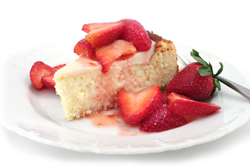 Blue Ribbon
Cheesecake Blue Ribbon
Cheesecake
We know why this is called the
Blue Ribbon Cheesecake - it has all of the qualities of a
winner! This basic cheesecake is a great place to start if
you're a newbie to baking your own cheesecakes. The recipe
went together quickly, lofted nicely, and tasted just how we
thought a cheesecake should taste. We agree with George's
mother who likes this recipe the best!
Click here to view the full,
illustrated recipe.
Click here for a printable
version of the recipe. (PDF
format)
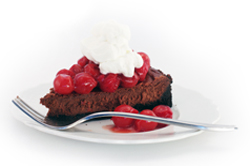 Black Forest
Cheesecake Black Forest
Cheesecake
This classic combination of
chocolate and cherries is reinvented in this cheesecake. The
crust is made of chocolate sandwich cookies with the crème
filling adding a bit of "extra" to the final result. The
bittersweet chocolate combined with the cheese, produced some
kind of dessert dreamland in our mouth. The cherries and
whipped cream completed the moment.
Click here to view the full,
illustrated recipe.
Click here for a printable
version of the recipe. (PDF
format)
 Pesto Sun-Dried Tomato
Cheesecake Pesto Sun-Dried Tomato
Cheesecake
If you're unfamiliar with
savory cheesecakes, this is a great recipe with which to
experiment. The fresh flavors of basil and garlic combine with
the intensity of sun-dried tomatoes to create a scrumptious
wedge. We served it once as a luncheon entrée, and a second
time as an appetizer spread on crackers. Tasty, rich and
wonderfully different!
Click here to view the full,
illustrated recipe.
Click here for a printable
version of the recipe. (PDF
format)
| |
| Make a
dessert date soon with your favorite
cheesecake!
|
|
| |